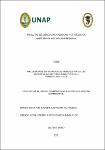Influencia de la rotación de mercadería en las ventas de la empresa Socopur S.A.C., periodo 2014 - 2018
Abstract
La gestión de inventarios es vital en cualquier empresa moderna, ya que busca optimizar el nivel de mercadería, tratando no tener demasiado que signifique dinero inmovilizado, ni tan poco que no alcance para atender los requerimientos. El objetivo de la investigación fue determinar la influencia de la rotación de mercadería en las ventas de la empresa SOCOPUR S.A.C., en el periodo 2014 - 2018; ejecutándose en ese sentido esta investigación de tipo Cuantitativa, nivel Correlacional y de diseño No Experimental. La investigación concluye que no existe relación alguna entre el stock de mercadería y las ventas de la empresa, contrastado mediante el test estadístico que utilizó el Coeficiente de Correlación ( r ) que fue de r = -0.621684272; muy alejado de +1 y -1 demostrando que no existe asociación entre variables; y el Coeficiente de Correlación ( R2 ) que resultó R2 = 0.386491335; lejos de 1; mostrando que la variación del stock de mercadería no determina las ventas. El stock de mercadería mantuvo una tendencia creciente durante toda la serie en estudio, iniciando el año 2014 con un valor de S/. 6,107,607.60 y finalizó el 2018 con S/. 7,832,182.62. Las ventas presentaron similar tendencia siendo de S/. 8,521,821.43 el año 2014, y terminando el año 2018 con S/. 31,767,268.90. Por otro lado, el análisis de las ventas a través de la condición de pago, demuestra que el 60% fueron “Al Crédito” mientras que el 40% fue “Al Contado”, restándole liquidez. Inventory management is vital in any modern company, since it seeks to optimize the level of merchandise, trying not to have too much that means immobilized money, nor so little that it is not enough to meet the requirements. The objective of the investigation was to determine the influence of the turnover of merchandise on the sales of the company SOCOPUR S.A.C., in the period 2014 - 2018; In this sense, this research of the Quantitative type, Correlational level and Non-Experimental design is executed. The investigation concludes that there is no relationship between the merchandise stock and the sales of the company, contrasted by the statistical test that used the Correlation Coefficient (r), which was r = -0.621684272; very far from +1 and -1 demonstrating that there is no association between variables; and the Correlation Coefficient (R2) that resulted in R2 = 0.386491335; away from 1; showing that the variation in merchandise stock does not determine sales. The merchandise stock maintained a growing trend throughout the series under study, starting 2014 with a value of S /. 6,107,607.60 and ended 2018 with S /. 7,832,182.62. Sales showed a similar trend, being S /. 8,521,821.43 in 2014, and ending 2018 with S /. 31,767,268.90. On the other hand, the analysis of sales through the payment condition shows that 60% were “Credit” while 40% were “Cash”, subtracting liquidity.
Collections
- Tesis [500]


